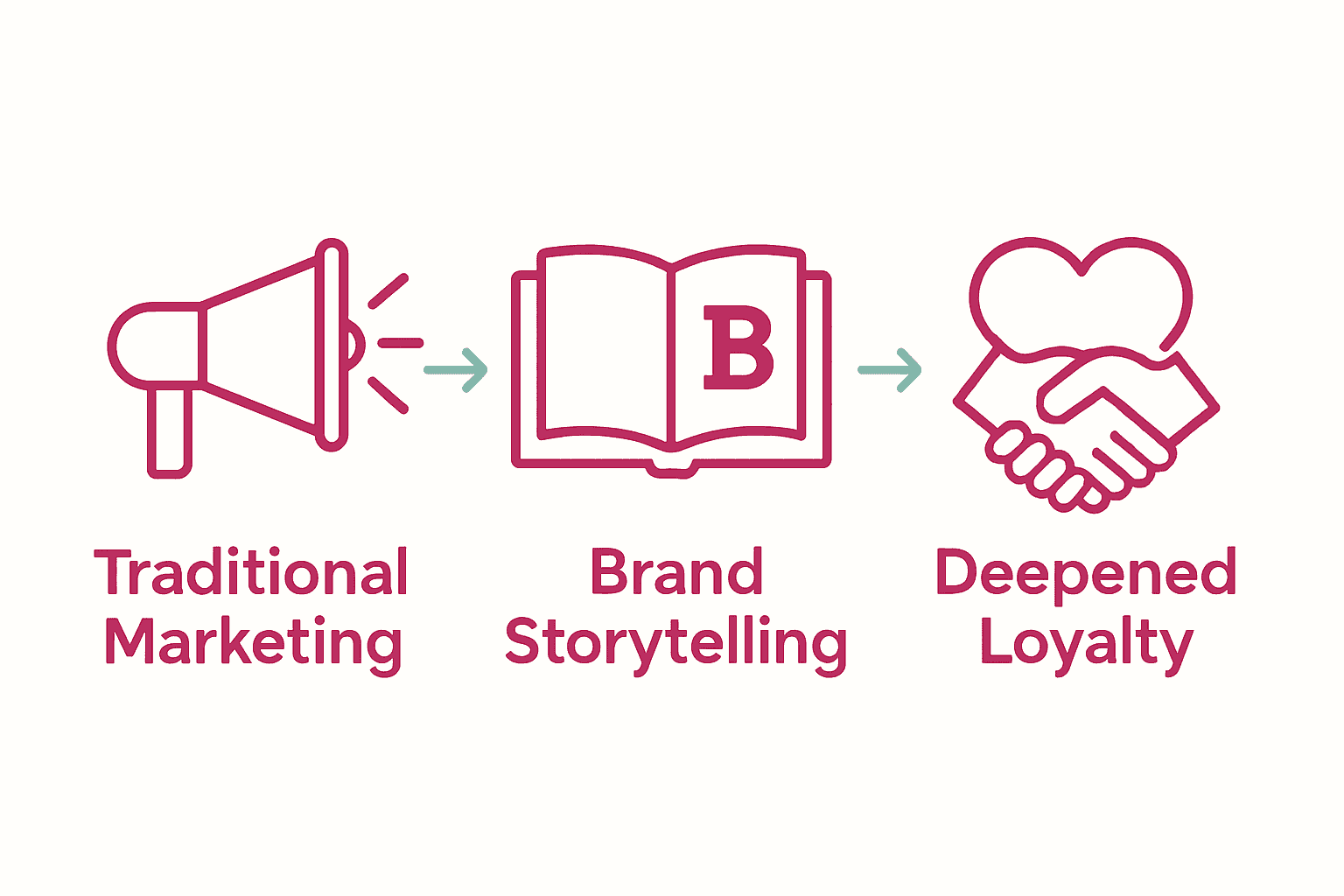Brand Storytelling Explained: Complete eCommerce Guide
- Darren Burns
- Oct 31
- 6 min read

Did you know that nearly 55 percent of consumers are more likely to buy from brands with authentic stories? Trust matters now more than ever when people shop online. With endless choices just a click away, stories help brands stand out and stick in people’s minds. By uncovering how eCommerce brands use storytelling, you will discover what truly sets winning brands apart and learn how to spark lasting connections with customers.
Table of Contents
Key Takeaways
Point | Details |
Strategic Brand Storytelling | Brand storytelling enhances eCommerce by articulating a brand’s unique identity and values, fostering consumer engagement beyond traditional marketing. |
Emotional Connection | Successful storytelling relies on creating emotional ties with customers, transforming transactions into meaningful relationships that foster loyalty. |
Effective Strategies | Diverse storytelling strategies, such as audience-centered narratives and mission-focused communication, can significantly enhance brand engagement and recognition. |
Common Pitfalls | Brands must avoid mistakes like inauthentic narratives and inconsistent messaging to maintain credibility and resonance with their target audience. |
Defining Brand Storytelling for eCommerce
Brand storytelling represents a strategic approach for eCommerce businesses to communicate their unique identity beyond traditional product descriptions. According to research from drpress, it involves using narrative techniques to shape a brand’s distinctive image and values across social platforms, ultimately promoting brand awareness and stimulating consumer engagement.
In the digital marketplace, brand storytelling transforms how businesses connect with potential customers. Europeanscience highlights that content marketing has evolved from conventional advertising to more emotionally resonant storytelling, allowing brands to create a compelling narrative that distinguishes them from competitors.
Effective brand storytelling in eCommerce typically encompasses several key elements:
Authentic representation of brand values
Consistent messaging across multiple platforms
Emotional connection with target audience
Transparent communication about brand origins
Narrative that goes beyond product specifications
The ultimate goal of brand storytelling is not merely to sell products but to create a meaningful relationship with consumers. By sharing genuine experiences, challenges overcome, and core mission, eCommerce brands can transform transactional interactions into lasting connections that inspire customer loyalty and trust.

Types of Brand Storytelling Strategies
Brand storytelling is a nuanced art with multiple strategic approaches. According to Indeed, eCommerce businesses can leverage several distinct storytelling strategies to connect with their audience effectively, ranging from audience-centered narratives to mission-focused communication.
The digital landscape offers innovative storytelling techniques that transcend traditional marketing methods. NxtBrandUp highlights emerging interactive storytelling strategies that incorporate cutting-edge technologies like augmented reality and 3D animation, enabling brands to create immersive web experiences that captivate potential customers.
Key types of brand storytelling strategies include:
Here’s an overview of key brand storytelling strategies and their core characteristics:
Strategy Type | Main Focus | Example Methods |
Audience-Centred Narratives | Customer experiences | Case studies Personal anecdotes |
Character-Driven Stories | Real people or journeys | Team profiles Founder stories |
Mission-Focused Communication | Values and social impact | Sustainability stories Philanthropy |
Customer Testimonial Approach | Authentic user experiences | Reviews User-generated content |
Data-Driven Storytelling | Insights and metrics | Infographics Data visualisation |
Audience-Centered Narratives: Stories that directly address customer experiences and perspectives
Character-Driven Stories: Focusing on real people behind the brand or customer journeys
Mission-Focused Communication: Highlighting brand values and social impact
Customer Testimonial Approaches: Leveraging authentic customer experiences
Data-Driven Storytelling: Using insights and metrics to craft compelling narratives
Successful eCommerce brands understand that effective storytelling is about creating emotional connections. By selecting the right storytelling strategy, businesses can transform simple product presentations into engaging narratives that resonate deeply with their target audience, ultimately driving engagement and building lasting customer relationships.
Core Elements That Make Stories Effective
Crafting a compelling brand story requires more than just stringing words together. Storychief emphasizes that emotional engagement is crucial, with humor playing a powerful role in making narratives more enjoyable and memorable for audiences.
Beyond entertainment, successful brand storytelling must connect with deeper values and principles. Spocket demonstrates how brands like Allbirds have successfully integrated storytelling with meaningful commitments, such as sustainability, which resonate profoundly with conscientious consumers who seek more than just products.
The core elements that transform an ordinary narrative into an extraordinary brand story include:
Authenticity: Genuine representation of brand identity
Emotional Resonance: Creating connections beyond transactional interactions
Clear Purpose: Communicating why the brand exists
Consistent Messaging: Maintaining a unified narrative across platforms
Human-Centric Approach: Focusing on relatable experiences and perspectives
Ultimately, effective storytelling in eCommerce transcends traditional marketing. It’s about creating a narrative that invites customers into your brand’s world, making them feel understood, valued, and part of something larger than a simple purchase transaction. By masterfully weaving these core elements together, brands can turn casual browsers into passionate, loyal advocates.
Benefits and Measurable Impact on Brands
Brand storytelling delivers substantial strategic advantages that extend far beyond traditional marketing approaches. ArXiv reveals that electronic word-of-mouth (eWoM) significantly influences brand image, creating enhanced brand relationships and establishing a competitive advantage in crowded digital marketplaces.
Moreover, effective storytelling directly impacts consumer perception and purchasing behavior. According to research from ArXiv, strategic brand narratives can evoke positive emotions, boost customer confidence, and reduce perceived purchasing risks, ultimately influencing purchase intentions more effectively than conventional advertising methods.
Key measurable benefits of brand storytelling include:
Increased Brand Awareness: Expanding market visibility and recognition
Enhanced Customer Loyalty: Creating deeper emotional connections
Improved Engagement Metrics: Higher interaction rates across digital platforms
Reduced Customer Acquisition Costs: More organic, trust-based conversions
Stronger Competitive Differentiation: Establishing a unique market position
Ultimately, brand storytelling transforms marketing from a transactional interaction to a meaningful dialogue. By crafting narratives that resonate authentically with target audiences, eCommerce brands can create lasting impressions that drive not just immediate sales, but long-term customer relationships and sustainable business growth.

Common Mistakes and How to Avoid Them
Brand storytelling in eCommerce is a delicate art, and many businesses stumble by misunderstanding their audience’s emotional landscape. Webscoot emphasizes the critical importance of understanding the emotional triggers that resonate with your target market and comprehending the narratives that genuinely connect with potential customers.
Tagalys highlights that visual storytelling requires more than just attractive imagery. Successful brands must ensure their visual narratives align seamlessly with core brand values, preventing potential disconnects that could lead to customer disengagement and lost opportunities.
Common brand storytelling mistakes to avoid include:
Inauthentic Narratives: Creating stories that feel forced or disconnected from brand identity
Inconsistent Messaging: Presenting conflicting stories across different platforms
Overlooking Audience Insights: Failing to understand customer emotional needs
Generic Storytelling: Using bland, undifferentiated narratives
Neglecting Visual Cohesion: Misaligning visual elements with brand story
The key to avoiding these pitfalls is maintaining genuine, consistent, and emotionally intelligent storytelling. By deeply understanding your audience, remaining true to your brand’s core values, and crafting narratives that genuinely reflect your unique identity, you can create powerful stories that not only capture attention but also build lasting customer relationships.
Transform Your eCommerce Brand Through Powerful Storytelling
Struggling to create authentic and emotionally engaging narratives that truly connect with your customers Can your brand storytelling deliver increased loyalty and meaningful engagement rather than just product pitches Our expertise at iwanttobeseen.online directly addresses these challenges by combining proven SEO, AI, social media, and PPC strategies crafted to amplify your unique brand story

Elevate your eCommerce presence with our specialised digital marketing services designed around your core brand values and customer insights We understand the critical need for consistent messaging and authentic connections highlighted in the complete eCommerce guide on brand storytelling Now is the time to turn your narratives into measurable growth and lasting relationships Discover how you can start building this with iwanttobeseen.online — your partner with over 25 years of experience scaling successful eCommerce brands Contact us today for a personalised strategy that brings your story to life
Frequently Asked Questions
What is brand storytelling in eCommerce?
Brand storytelling in eCommerce is a strategic approach that uses narrative techniques to communicate a brand’s unique identity, values, and message, fostering deeper connections with consumers beyond traditional product descriptions.
Why is emotional engagement important in brand storytelling?
Emotional engagement is crucial because it helps to create connections between the brand and the consumer. Engaging stories resonate on a deeper level, enhancing customer loyalty and making brand interactions more meaningful.
What are some effective strategies for brand storytelling?
Effective strategies include audience-centered narratives, character-driven stories, mission-focused communication, customer testimonials, and data-driven storytelling, each focused on crafting engaging narratives that resonate with the target audience.
What are the measurable benefits of brand storytelling?
The measurable benefits of brand storytelling include increased brand awareness, enhanced customer loyalty, improved engagement metrics, reduced customer acquisition costs, and stronger competitive differentiation, ultimately leading to more sustainable business growth.
Recommended
.png)
Comments